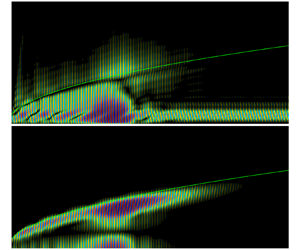Article contents
Global receptivity analysis: physically realizable input–output analysis
Published online by Cambridge University Press: 03 February 2023
Abstract

In the context of transition analysis, linear input–output analysis determines the worst-case disturbances to a laminar base flow based on a generic right-hand-side volumetric/boundary forcing term. The worst-case forcing is not physically realizable, and, to our knowledge, a generic framework for posing physically realizable worst-case disturbance problems is lacking. In natural receptivity analysis, disturbances are forced by matching (typically local) solutions within the boundary layer to outer solutions consisting of free-stream vortical, entropic and acoustic disturbances. We pose a scattering formalism to restrict the input forcing to a set of realizable disturbances associated with plane-wave solutions of the outer problem. The formulation is validated by comparing with direct numerical simulations of a Mach 4.5 flat-plate boundary layer. We show that the method provides insight into transition mechanisms by identifying those linear combinations of plane-wave disturbances that maximize energy amplification over a range of frequencies. We also discuss how the framework can be extended to accommodate scattering from shocks and in shock layers for supersonic flow.
- Type
- JFM Rapids
- Information
- Copyright
- © The Author(s), 2023. Published by Cambridge University Press
References
REFERENCES
- 11
- Cited by



